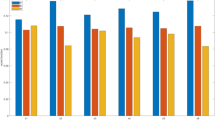Abstract
In this paper, we propose two new three-way decision models based on decision-theoretic rough sets with single-valued neutrosophic information. These two models adopt different ranking methods, one of which is the ranking method based on cosine similarity measure. The other is the ranking method based on Euclidean distance. The key steps of the proposed models were shown by an algorithm and we present the breakfast shop siting problem to demonstrate the rationality and practicability of the proposed models. Finally, we make comparison analysis between the two models, and compare our models with other existing related models.
Similar content being viewed by others
Explore related subjects
Discover the latest articles, news and stories from top researchers in related subjects.References
Abdel-Basset M, Manogaran G, Mohamed M, Chilamkurti N (2018) Three-way decisions based on neutrosophic sets and AHP-QFD framework for supplier selection problem. Future Gen Comput Syst 89:19–30
Atanassov KT (1986) Intuitionistic fuzzy sets. Fuzzy Sets Syst 20:87–96
Hao L, Feng Y, Mi JS (2017) Three-way decisions for composed set-valued decision tables. J Intell Fuzzy Syst 33:937–946
Hu BQ (2014) Three-way decisions space and three-way decisions. Inf Sci 281:21–52
Hu BQ, Wong H, Yiu KC (2017) On two novel types of three-way decisions in three-way decision spaces. Int J Approx Reason 82:285–306
Huang CC, Li JH, Mei CL (2017) Three-way concept learning based on cognitive operators: an information fusion viewpoint. Int J Approx Reason 83:218–242
Jia F, Liu PD (2019) A novel three-way decision model under multiple-criteria environment. Inf Sci 471:29–51
Jiang CM, Yao YY (2018) Effectiveness measures in movement-based three-way decisions. Knowl Based Syst 160(15):136–143
Lang GM, Miao DQ, Cai MJ (2017) Three-way decision approaches to conflict analysis using decision-theoretic rough set theory. Inf Sci 406:185–207
Li JH, Huang CC, Qi JJ, Qian YH, Liu WQ (2017) Three-way cognitive concept learning via multi-granularity. Inf Sci 378:244–263
Liang DC, Liu D (2014) Systematic studies on three-way decisions with interval-valued decision-theoretic rough sets. Inf Sci 276:186–203
Liang DC, Liu D (2015) Deriving three-way decisions from intuitionistic fuzzy decision-theoretic rough sets. Inf Sci 300:28–48
Liang DC, Xu ZS, Liu D (2017) Three-way decisions based on decision-theoretic rough sets with dual hesitant fuzzy infromation. Inf Sci 396:127–143
Liu D, Liang DC (2017) Three-way decisions in ordered decision system. Knowl Based Syst 137:182–195
Luo C, Li TR, Huang YY, Fujita H (2019) Updating three-way decision in incomplete multi-scale information systems. Inf Sci 476:274–289
Majumdar P, Samanta SK (2014) On similarity and entropy of neutrosophic sets. J Intell Fuzzy Syst 26:1245–1252
Pawlak Z (1982) Rough sets. Int J Comput Inf Sci 11:341–356
Peng JJ, Wang JQ, Zhang HY, Chen XH (2014) An outranking approach for multi-criteria decision-making problems with simplified neutrosophic sets. Appl Soft Comput 25:336–346
Qian J, Liu CH, Xu XD (2019) Multigranulation sequential three-way decisions based on multiple thresholds. Int J Approx Reason 105:396–416
Smarandache F (1998) Neutrosophy. Neutrosophic probability, set and logic. American Research Press, Rehoboth
Smarandache F, Vladareanu L (2011) Applications of neutrosophic logic to robotics: an introduction. In: 2011 IEEE international conference on granular computing, pp 607–612
Singh PK (2018) Three-way n-valued neutrosophic concept lattice at different granulation. Int J Mach Learn Cybern 9(11):1839–1855
Singh PK (2017) Three-way fuzzy concept lattice representation using neutrosophic set. Int J Mach Learn Cybern 8(1):69–79
Wang PX, Yao YY (2018) CE3: a three-way clustering method based on mathematical morphology. Knowl Based Syst 155:54–65
Wang H, Smarandache F, Zhang YQ, Sunderraman R (2010) Single-valued neutrosophic sets. Multisp Multistruct 4:410–413
Yao YY (2010) Three-way decisions with probabilistic rough sets. Inf Sci 180:341–353
Yao YY (2012) An outline of a theory of three-way decisions. In: Rough sets and current trends in computing-8th international conference, RSCTC 2012, Chengdu, China, August 17–20, LNCS(LNAI), vol 7413, pp 1–17
Yao YY (2018) Three-way decision and granular computing. Int J Approx Reason 103:107–123
Ye J (2013) Multicriteria decision-making method using the correlation coefficient under single-valued neutrosophic environment. Int J Gen Syst 42:386–394
Ye J (2013) Another form of correlation coefficient under single-valued neutrosophic sets and its multiple attribute decision-making method. Neutrosophic Sets Syst 1:8–12
Zadeh LA (1965) Fuzzy sets. Inf Control 8(3):338–356
Zhang QH, Xia DY, Liu KX, Wang GY (2020) A general model of decision-theoretic three-way approximations of fuzzy sets based on a heuristic algorithm. Inf Sci 507:522–539
Zhang XH, Bo CX, Smarandache F, Dai JH (2018) New inclusion relation of neutrosophic sets with applications and related lattice structure. Int J Mach Learn Cybern 9(10):1753–1763
Zhang Y, Yao JT (2017) Gini objective functions for three-way classifications. Int J Approx Reason 81:103–114
Zhao XR, Hu BQ (2020) Three-way decisions with decision-theoretic rough sets in multiset-valued information tables. Inf Sci 507:684–699
Acknowledgements
The authors would wish to thank the anonymous referees and editors for their valuable comments and helpful suggestions which have helped improve this paper significantly. This work is supported by the NNSF of China (Nos. 61473181 and 11771263) and the Fundamental Research Funds for the Central Universities (No. GK201702008).
Author information
Authors and Affiliations
Corresponding author
Additional information
Publisher's Note
Springer Nature remains neutral with regard to jurisdictional claims in published maps and institutional affiliations.
Rights and permissions
About this article
Cite this article
Jiao, L., Yang, HL. & Li, SG. Three-way decision based on decision-theoretic rough sets with single-valued neutrosophic information. Int. J. Mach. Learn. & Cyber. 11, 657–665 (2020). https://doi.org/10.1007/s13042-019-01023-3
Received:
Accepted:
Published:
Issue Date:
DOI: https://doi.org/10.1007/s13042-019-01023-3




